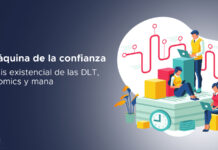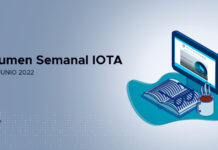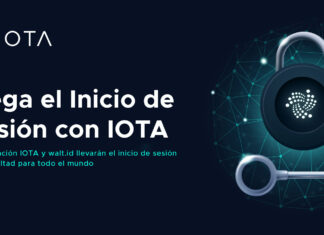
Some months ago I found about XDK2MAM and did some review of the project. As Founder of IOTA Latino, I was interested on what this project could enable in Venezuela and the Caribbean, where we are working hard to adopt Tangle and designing some proofs of concept as we study the IOTA protocol in depth.
So I contacted Daniel De Michele and Alejandro Elustondo, from Argentina to start discussing how we could work together in the region and ended up inviting them to our next IOTA Latino Meetup in December.
This interview, the first one I am doing for IOTA Hispano, aims to get a better understanding of what this project is about and why I believe it will be important for IOTA as it will allow others to prototype IoT.
Let’s get to know the founders and their vision.
Saul Ameliach
IOTA Latino Founder
If you like what we are doing help us to continue working! Donate: https://iotahispano.com/donate/
Tell us a bit about your backgrounds and how you ended up being interested by DLTs.
Daniel: I am a self taught Fullstack Web Developer, Head of WebDev Area in the Universidad Nacional de Entre Ríos and Linux Sysop with focus in HA and webservers. I also hold a Bachelor’s degree in Labour Relations. I have been curious about technology since I got my first computer at home (i386, 1993 maybe). Started doing my first webpages in 1999 using Frontpage and soon I moved on to CGI and later PHP and Python over LAMPP stack. By this days I am transitioning to Node.js as I understand it fits better my projects needs. By 2012 I entered to the Darkweb via Tor Browser and found the Hidden Wiki. That was the start of my journey through a lot of webs that used Bitcoin as anonymous payment system. Unfortunately, it bought my first Bitcoins in 2013, when they were something like 90USD and got interested by this new online payment method immediately. Did some reading, forked a Litecoin version to create my own altcoin with educational purposes and, since then, I am convinced about the impact DLTs will have in the future.
Alejandro: My interest in technology started when I was a kid. When I was 12 (2005) my older brother bought the book of B.W. Kernighan & D.M. Ritchie called ‘The C programming language’, which I began to read. As I finished every chapter my interest in the world of programming got bigger and bigger. The following year I entered a technical secondary school specialized in computing and I got my Computers Technician title. I remember that in 2015 I was studying Computer Security (a subject) and in one of the classes they tried to explain the operation of Bitcoin. Because of this, I started researching about blockchain until one day I found IOTA.
I am currently finishing my Systems Engineer degree at Universidad Tecnológica Nacional (UTN) and work as a software developer for C & S Informática which is an Argentine Software Engineering company.
What were your initial thoughts when you first heard about IOTA and the Tangle?
Daniel: I still remember the day IOTA got listed in Finex and came up in the Coinmarketcap top 10. I headed to their website to found that this guys were aiming to be the backbone of IoT. Knowing the scalability limitations blockchain has as data structure first thing I thought was “yeah, right …” Then I read a bit more, ended up trying to grasp Popov’s whitepaper and concluded that, if this was possible the potential could be huge …
Alejandro: The first time I heard about IOTA was due to a practical job that I had to deliver at the University. The only premise of the work was that it should be traceable with the possibility of replacing the fiat money, so I started researching and looking for alternatives to blockchain and I came across the IOTA whitepaper, written by Dr. Popov. After running into the whitepaper I was totally fascinated, so I proposed myself to explain it because at that time (September 2017) there was no documentation in Spanish regarding IOTA and its operation. It was just at that moment in where I met Carpincho (Daniel) who was just starting Iota Hispano and offered him my work so that it could be available to the Hispanic community.
You Co-Founded XDK2MAM, would you tell us about how all that started?
Daniel & Alejandro: Long story short, we ended up with XDKs in our hands and found that there were no easy to implement open source solutions to take the sensor’s data via all the available methods and publish it to the Tangle.
After seeing Paul Handy’s Masked Authenticated Messaging (MAM) presentation at Chicago Connectory, we decided to get one of those XDK110 he spoke about to play with. Soon after we were running the Workbench examples (XDK110 comes with an Eclipse based IDE and many basic examples to get you started) but we found out that there was no integration with IOTA available. Yes, there was some code for MQTT to publish some sensors data, but that was not enough.
By those days we were discussing in an argentinian devs group what would be our first PoC and we kind of connected the dots… We really like those amazing futuristic PoCs out there but strongly believe that if you find something that has not been solved yet, and by doing it you add value to the project, you should go for it.
So we started working on the C code (Alejandro is an amazing C dev!) while begun building a brand, webpage and modeled the project scope and roadmap.
What’s with the name XDK2MAM, how did that come up?
Nothing fancy here. We needed a name that could explain what the project was about and ended up going the easy way. I think it was a good decision since you get the picture (and it is not a small one) at a first glance.
Daniel Trauth and his IILA are pioneers in Internet of Production. How did you meet him and how did he end up being XDK2MAM advisor?
We knew Daniel Trauth and his amazing work at IILA from the IOTA Evangelist Network. We talked with him a lot about Bosch XDKs way before we got our first units and eventually ended up exchanging some code. When we decided to start this project we consulted him: in our minds, if there was someone who could test and evaluate our code, that was Daniel and his amazing engineers team. As usual, he was extremely kind with us and that gave us the push to ask him if he would be willing to be our Advisor. When he replied that he was in, we thought, “ok, now this is serious”. Daniel Trauth is a very down to earth man and a big enabler.
How important you think the Bosch XDK 110 is considering its price?
The XDK 110 was been used internally at Bosch till they decided to start commercializing it because they considered that it could be of help for others prototyping IoT. It might be a bit expensive compared to other boards, but we think it is an amazing piece of hardware with no competitors so far.
Many people think they can get the same using an Arduino and that’s fine. Go for it! In our experience you can’t get what the XDK110 delivers by using Arduino. You might be able to replicate all the functionality but you will end up with a big set of components that will not be as stable as XDK 110 is. You can ride your bicycle to work with an XDK in your pocket. Try that with your Arduino clon. Another big plus is how strong they are! We had many accidents in which they just hit the floor and nothing happened. This is really important: go place your Arduino based clon on a vibrating machine and see how board and sensors pins behave after some days …
Regarding the price, we don’t think they are that expensive. If you compare them with something built with Arduino, they might seem expensive, but, as we just said, this is a one of a kind piece of hardware and does not play in the Arduino leagues. Let’s just give the product some time as they might get a bit cheaper if more adoption occurs.
Could you provide examples about things that can be done using Bosch XDK 110 and IOTA?
On the Bosch side you get an Accelerometer, Magnometer, Gyroscope, Light, Acoustic and Temp/Pressure/Humidity sensors with WiFi and Bluetooth connectivity + a microSD slot. On the IOTA side you get the ability to decentralize this data, meaning that information published becomes immutable. On one hand you have a source for multiple data + connectivity, in the other you have means to grant that the data published to the Tangle is genuine and can’t be corrupted.
What do you want to measure? You can have a weather station or any other combination of data provided by the given sensors offered in the IOTA Datamarket waiting for someone to buy it, because they need that information.
XDK 110 is being used to meassure industrial machinery and enviromental behavior, so you could, for instance, attach one of this sensord node to a given set of equiments to compare the data they produce and find any asymetric behaviors that could point to malfunction or ambiental changes at some given places. By publishing this information to the Tangle you could then offer it to the machines manufacturer as they could be interested in having data showing how their equipments behave in different conditions around the world. This is just one of many examples that can be deployed using the «data is the new oil» paradigm.
At which stage the project currently is?
Our roadmap is available in our website. They idea is to start providing solutions to connect XDK with the Tangle via all the existing methods (HTTP/MQTT/BLE/UDP), continue by creating a Panel to visualize and use all the information setting some behaviors based on data and providing statistics, and to finish providing a All-in solution to allow the XDK to publish its data straight to the Tangle without need of any external service.
It might not seem a lot but trust us when we say it is. We are always exploring the hardware capabilities and seeking for ways to get what we want to do in the best and easier way. XDK2MAM is an open source project trying to get anyone with computer skills to successfully connect this piece of hardware with the Tangle. It’s not only about getting to work, it has to be easy to implement and well designed at the same time.
What is your relation with Bosch and the IOTA Foundation?
XDK2MAM is an IOTA Ecosystem project and, despite what some online magazines posted, we are not part of IF nor Bosch. That being said, we got good feedback from both parties and were invited to be part of the IOTA Datamarket. On the Bosch side, we are in touch with some of the people working on Bosch Connectivity, such as Reiner Schmodl (XDK Product Manager), and they have been supportive regarding our work as an extension of what the XDK 110 can deliver in the field of DLTs.
We know XDK2MAM does workshops. What is that experience about and why do you think it is important?
It’s not easy to explain to people not familiarized with IOTA what we do, but we have proven that when you show how it works and guide others through the process of have it working, things become very clear. This project is supposed to be for anyone with basic tech skills. To dictate workshops allows us to validate how good our work is. If most workshop participants can get things to work, then we make it.
Workshops consist on spreading XDKs among the attendees and guide them to get sensor’s data published on the Tangle. Once they manage to do this and they check their data is reachable at a IOTA Explorer, we take them through the process of publishing weather data to the IOTA Datamarket and offer it for sale. Usually by this point participants have a good understanding of what they just did, even when thay might not know the internals of the process reproduced.
We like to think in terms of «code and show», a motto related to be continuously validating that what you aim for is being achieved. This is why we try to do as «hands on» workshops as we can, and probably will go wherever we get invited to.
Are you guys considering to work with other hardware SDK?
At this point we are dedicating our efforts to the Bosch XDK 110. This is what XDK2MAM is. Once we finish our roadmap we will evaluate if we move on to continue integrating other SDKs with the Tangle or move to a different project. There is so much to do and so many ideas that this is not something to be concerned about.
How do you evaluate the IOTA Ecosystem in terms of contributions made to the IOTA project?
We consider the IOTA Ecosystem as a central piece to add value to the project from the community. There are a lot of very talented developers out there that will create amazing solutions or adapt existent projects to work over the Tangle if you give them an incentive. This way, IOTA Foundation can focus on protocol and core development and let integrations and proof of work to third party resources.



























